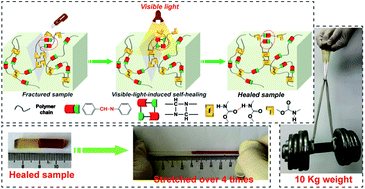Developing visible-light-induced dynamic aromatic Schiff base bonds for room-temperature self-healable and reprocessable waterborne polyurethanes with high mechanical properties†
Abstract
Herein, a novel type of visible-light-induced dynamic covalent bond was developed based on aromatic Schiff base (ASB) bonds, and the prepared waterborne polyurethanes containing dynamic ASB bonds (ASB-WPU) exhibited a desirable self-healability (healing efficiency of 83.8%) after healing under a commercial LED table lamp for 24 hours (temperature of ∼25 °C). Meanwhile, high mechanical properties (tensile stress of 14.32 MPa and toughness of 64.80 MJ m−3) could also be obtained, demonstrating a good balance of room-temperature self-healability and high mechanical properties in our polymers. The imine metathesis of ASB bonds and the H-bonded interactions between urethane groups could afford the ultimate healing result simultaneously, in which the imine metathesis of ASB bonds triggered by visible light is the main factor. Furthermore, these ASB-WPU polymers could also be reprocessed under visible light with well recovered mechanical properties. We envision that this elaborate design philosophy, based on the readily available, clean, safe and easily manipulable visible light, could provide inspiration for preparing room-temperature self-healable and reprocessable polymers with high mechanical properties, which are urgently needed for next-generation smart materials.



 Please wait while we load your content...
Please wait while we load your content...